To calculate the return on investment, a real estate investor would need to gather a large amount of data related to the different values and metrics that are needed for these calculations.
Below are some guidelines on the methods, values, and metrics used to calculate the return on investment, their effect on your results, and their formulas, as well as a real-life example of an investment property that is listed on Mashvisor and how the different values change depending on the adjustments made using our investment property calculator.
How to Calculate the Return on Investment?
Before purchasing any investment property, real estate investors are always advised to conduct investment analysis and to try and determine the return on investment to ensure that they will make a profit from their investment.
One of the major steps in any investment analysis is to calculate the return on investment.
Note: Already know how to calculate the return on investment? Click here to start searching for investment properties right away!
The return on investment can let the real estate investor know what to expect from purchasing an investment property and the amount of profit that it will generate before committing towards purchasing the property.
But there are a number of different metrics that are used in real estate investing to calculate the return on investment.
The two major metrics that are used to calculate the return on investment for an investment property in real estate are the cap rate and the cash on cash return.
There are, however, a number of different aspects and values that any real estate investor would also need to know or obtain in order to help him/her calculate the return on investment and achieve the most accurate results.
Related: Cap Rate vs. Cash on Cash Return
Cap Rate
The cap rate is a metric used to calculate the return on investment that an investment property will have based on the current market value of the property and the amount of NOI that it generates.
The formula for calculating the cap rate is:
Cap Rate = (NOI/Current Market Value) x 100
The value of the cap rate metric is typically expressed as a percentage, and it indicates the percentage of the property’s total value that you will be making in profit on annual basis.
For example, if you’re purchasing a property that has a current value of $400,000 and an NOI of $15,000, the cap rate for this property will be calculated as follows:
Cap Rate = ($15,000/$400,000) x 100
Cap Rate = 3.75%
This means that the property will generate a profit that is equal to 3.75% of its total value each year.
Cash on Cash Return
The cash on cash return is another metric used to calculate the return on investment in real estate based on the actual cash invested in the purchase of the property and its NOI.
The formula for calculating the cash on cash return is:
Cash on Cash Return = (NOI/Cash Invested) x 100
Similar to the cap rate, the cash on cash return value is expressed as a percentage, and it reflects the rate at which the property will generate its profit to cover the amount of cash that the real estate investor has used to purchase the property.
Consider our previous example, but this time you’re purchasing the property using 20% cash and 80% mortgage.
The calculation for the cash on cash return will only take into consideration the amount of cash invested ($400,000 x 20% = $80,000), leaving out the amount of borrowed money ($320,000).
Cash on Cash Return = ($15,000/$80,000) x 100
Cash on Cash Return = 18.75%
This means that the property will generate a profit that is equal to 18.75% of the amount of cash invested in it each year.
Other Values and Metrics
In order to calculate the return on investment with accurate results, a real estate investor would need to obtain several different values that are an inseparable part of the cap rate and cash on cash return calculations.
One of the major values that should be taken into consideration and that can drastically affect your NOI calculation is the vacancy rate of an investment property.
Vacancy Rate
The vacancy rate is the percentage of time during a year that the investment property is expected to be vacant (not rented out to tenants), and it directly affects the amount of rental income that the property will have.
The vacancy rate is typically included in the calculations as an expense. An investment property that has a vacancy rate of 20% will directly reduce your rental income by 20%, but it will not affect several of the expenses that will apply to your investment property even when it’s vacant.
Note: Click here to find investment properties with low vacancy rates!
Rental Income and Cash Flow
The rental income that an investment property has is the amount of rent that it will receive on a daily, weekly, monthly, or annual basis. The rental income does not take into account the expenses that will apply to the investment property, but it reflects the amount of rent that you will be able to charge your tenants for staying in the property.
The amount of rental income that the investment property has will directly affect its NOI, and therefore is a major metric that a real estate investor would need to know in order to calculate the return on investment using the cap rate and the cash on cash return formulas.
Learn: 6 Better Ways to Spend Rental Income
The cash flow, on the other hand, is very similar to the NOI in that it takes into account the amount of rental income as well as the expenses that will apply.
The cash flow of an investment property can either be positive or negative, and it is the actual amount of profit or loss that the investment property will generate.
The Financing Method
While the cap rate does not account for the financing method used to purchase the property, the cash on cash return value directly requires the real estate investor’s knowledge of the amount of actual cash that he/she will invest in the property.
Additionally, since one of the major expenses for an investment property is the amount of mortgage payments and interest rate, the method of financing the property is an important aspect that is required to calculate the return on investment at a higher efficiency.
A Real Investment Property Example
Let’s take a look at Mashvisor’s investment property calculator and how the different values can affect our calculations and the results we get in order to calculate the return on investment.
One of the properties listed on our platform in the Ann Arbor area is a 3 bedrooms/2 bathrooms single-family home that is listed at a price of $309,900.
Our default calculations for the property assuming that it will be purchased with 100% cash are as follows:
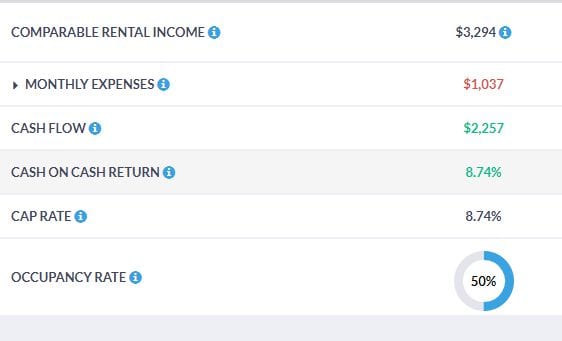
Investment Property Calculator
- Rental Income: $3,294
- Monthly Expenses: $1,037
- Cash Flow: $2,257
- Cash on Cash Return: 8.74%
- Cap Rate: 8.74%
- Vacancy Rate: 50%
Now, the first thing that you can notice from these values is that the cap rate and the cash on cash return values are identical. This is because the method of financing is set to all cash.
However, if we were to change the method of financing to 25% cash and 75% mortgage for a 30 years fixed loan with a 3.98% interest rate, the cap rate value will remain the same (the value of the property doesn’t change), but the cash on cash return value will increase to 16.15%.
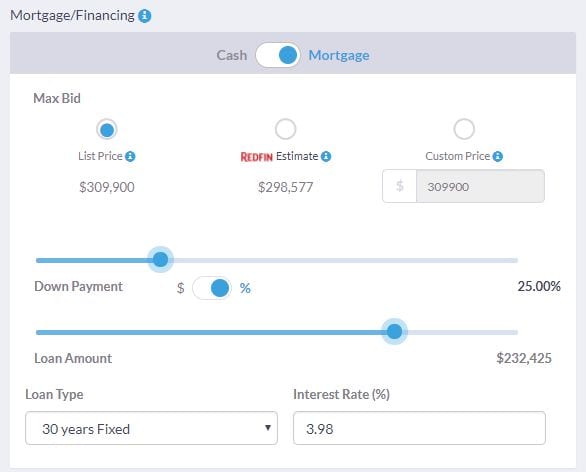
Cash/Mortgage Calculator
Additionally, setting the financing method to a 75% mortgage also increased the monthly expenses to $2,144 due to the addition of the mortgage payments and the interest rate, and the cash flow of the property was reduced to $1,150 as a result..
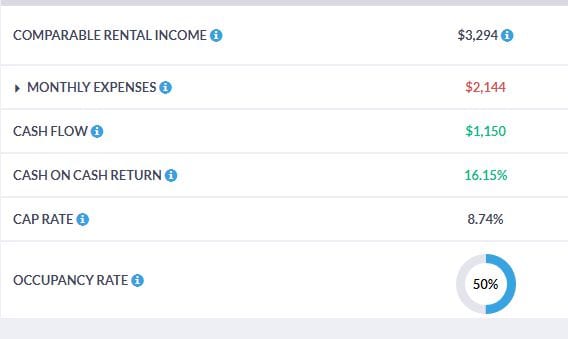
Investment Property Calculator
Now, let’s try to change the vacancy rate to 25% and see how it will affect the results.
Using the 75% mortgage option and a 25% vacancy rate for the investment property results in these new values:
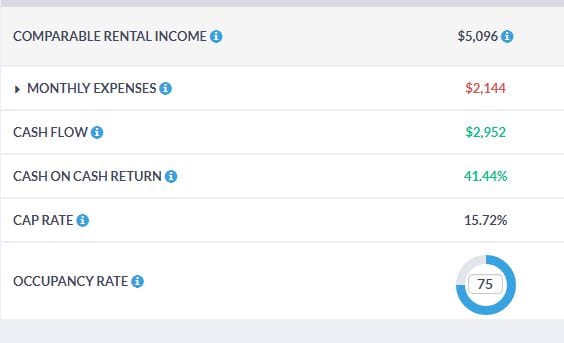
Investment Property Calculator
- Rental Income: $5,096
- Monthly Expenses: $2,144
- Cash Flow: $2,952
- Cash on Cash Return: 41.44%
- Cap Rate: 15.72%
- Vacancy Rate: 25%
As you can see, changing the vacancy rate and the financing method drastically changes all of these results when you calculate the return on investment.
This is because the two major aspects used to calculate the return on investment are the amount of profit and the amount of expenses that will apply.
Since the vacancy rate and the mortgage payments make up the biggest chunk of the expenses, increasing or reducing them will have a very noticeable effect on your calculations.
Of course, these calculations also take into account all the different expenses that will apply to the investment property, including the one-time startup costs (inspections, closing costs, appliances, etc.) as well as the recurring costs (insurance, taxes, property management, maintenance, etc.).
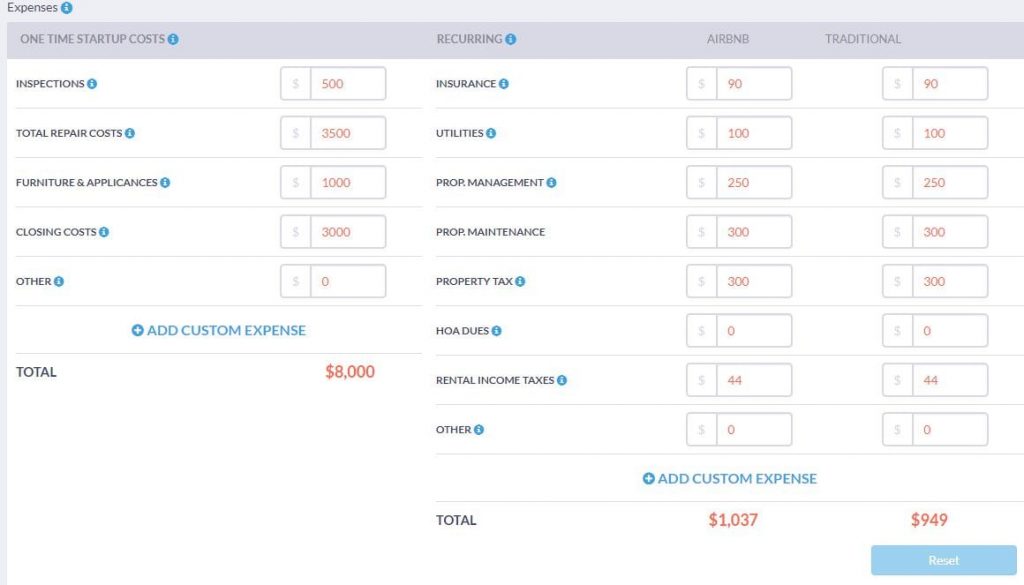
Expenses Calculator
Note: Click here to start searching for investment properties with readily available calculations!
Final Thoughts
In order to calculate the return on investment, a real estate investor is required to gather a sufficient amount of data for any investment property that he/she is considering before being able to calculate the return on investment with accurate results.
Additionally, as a part of investment analysis, a real estate investor is also required to conduct comparative market analysis, which means that he/she would have to gather this data for a number of properties within the market to determine the best performing investment property in comparison to other similar properties in the area.
To reduce the amount of time and effort needed to calculate the return on investment with efficiency and accuracy, Mashvisor has created an investment property calculator as well as a comparative market analysis tool which can help any real estate investor turn months of research into a few minutes.
Head over to Mashvisor and start analyzing your investments and calculate the return on investment quickly and with ease.